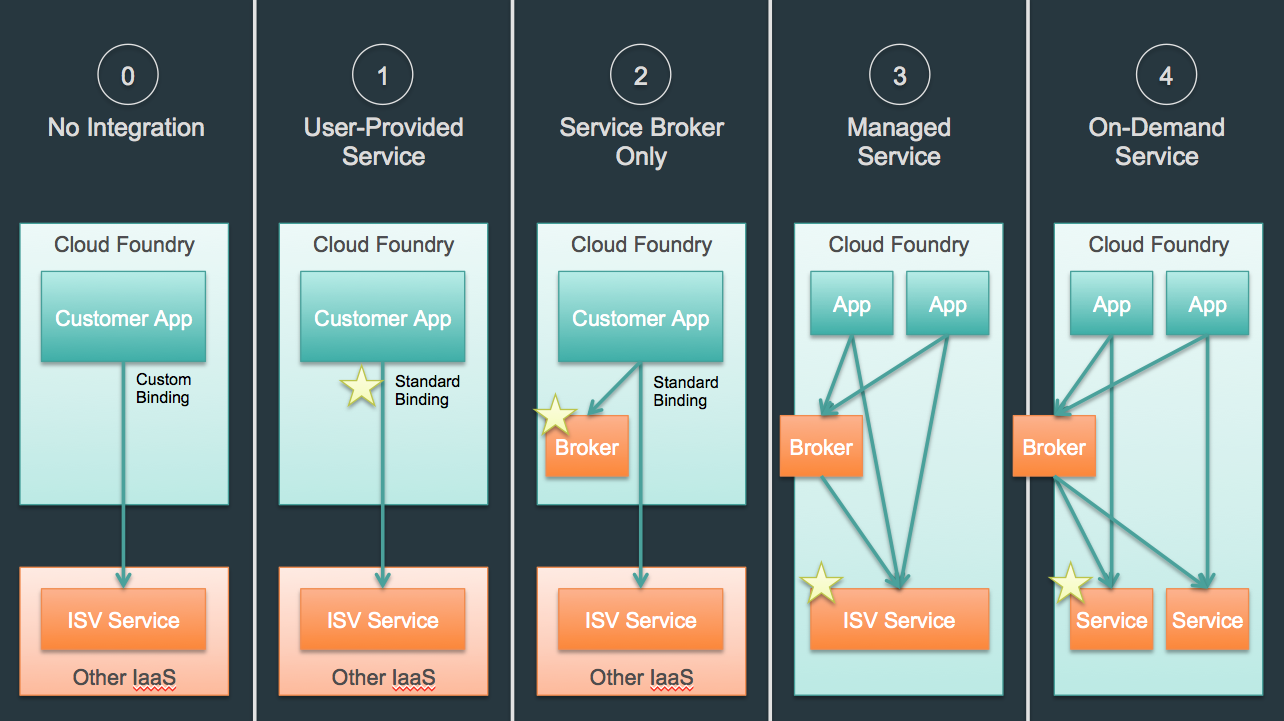You can use a service to integrate with VMware Tanzu Application Service for VMs at four levels, depicted here in order of increasing integration. In general, your user-experience and production-readiness improves as the integration level increases. But none of the higher levels is required.
You can stop service integration and declare it finished (sufficient) after any of these integration levels.
This staged approach allows early feedback on the value and the design of the integration, which helps make better decisions about future stages.
For non-service integrations, such as applications or buildpacks, a similar staged integration approach is often possible and desirable.

Level 1: User-provided service
The service runs external to TAS for VMs and has no service broker or tile. To use a service with an app, the developer creates a service broker by running cf create-user-provided-service from the Cloud Foundry Command-Line Interface (cf CLI).
Configuring, running, upgrading, and paying for a user-provided service are all up to the developer.
Level 2. Brokered service
A brokered service runs external to TAS for VMs, but has a tile on the Broadcom Support portal.
Broadcom Support portal designates brokered services by including “Service Broker for VMware Tanzu” in the name.
You can install, configure, and upgrade the tile through the Tanzu Operations Manager Installation Dashboard. Developers can see your service plans and create service instances in Apps Manager, or by running the cf marketplace and cf create-service commands.
For more information about brokered service tiles and how to create them, see Brokered Service.
Level 3. Managed service
In a managed service, both the service broker and the service itself run within TAS for VMs. TAS for VMs is activated to manage, monitor, and increase service performance.
As with the brokered service, the service has a service broker and a tile listed on the Broadcom Support portal. The Broadcom Support portal lists managed services as “
When you install the tile, you allocate a block of VMs to run service instances and provisions for CPU and memory resources.
For more information about managed service tiles and how to create them, see Managed Service.
Level 4: On-Demand (dynamic) service
Just as with a managed service, an on-demand service and broker both run within TAS for VMs, and the Broadcom Support portal lists the service tile. But unlike a managed service, an on-demand service does not limit the number of service instance VMs available for use. You do not have to pre-allocate and provision VM resources for the service.
When you create an instance for an on-demand service, they provision the resources (within an allowed range) and BOSH dynamically creates a new, dedicated VM for the instance.
For more information about On-Demand service tiles and how to create them, see On-Demand service.